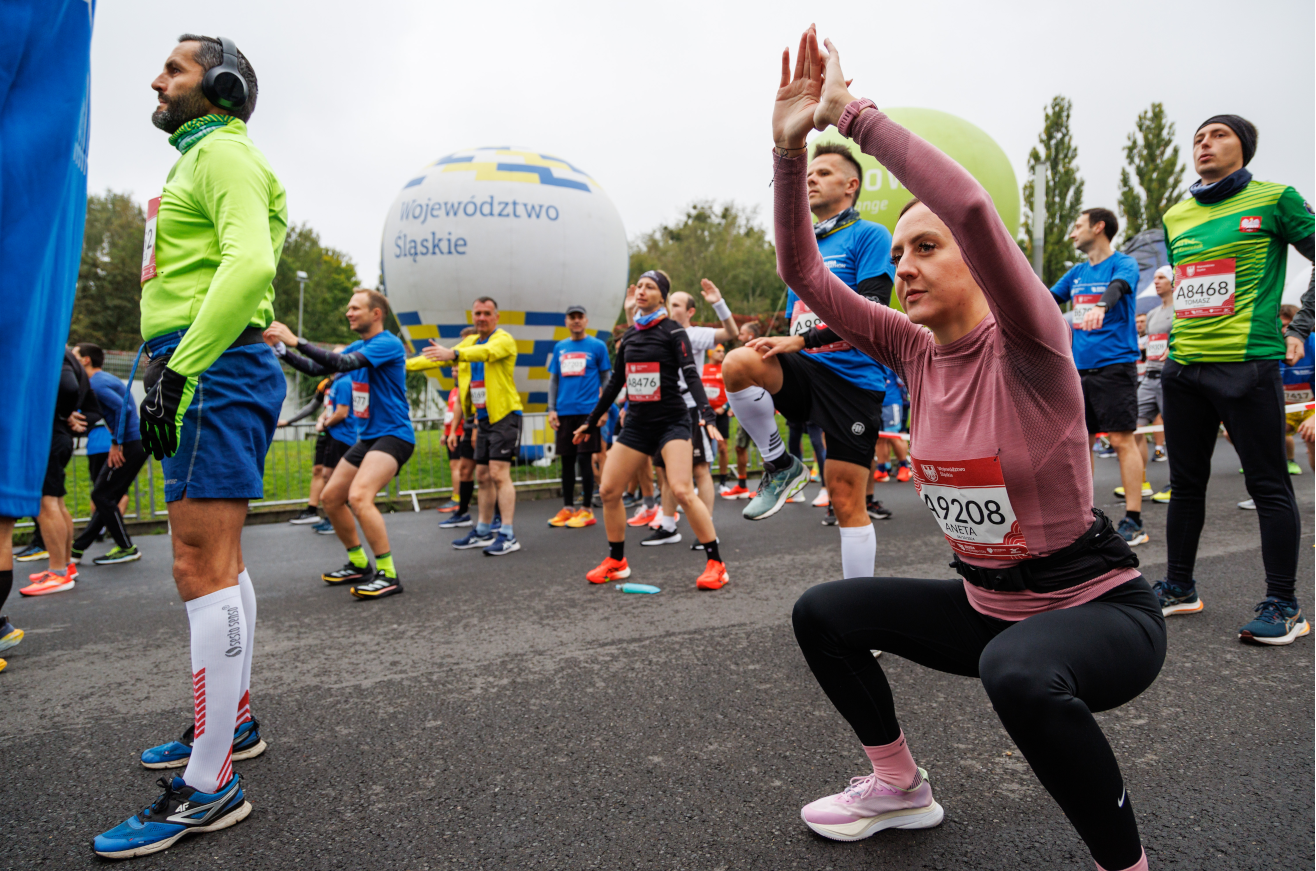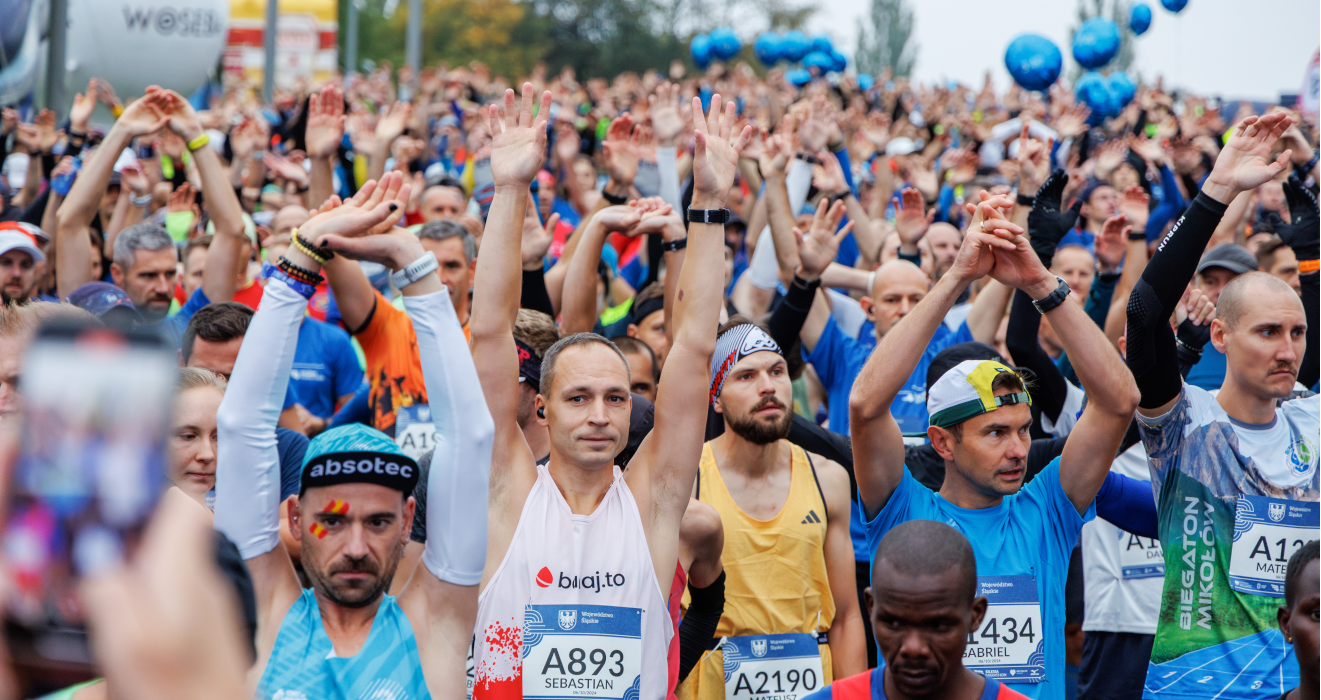Six months is enough time to prepare for a long-distance race. If you’re taking your first running steps, we’ll help you get ready for the Silesia Half Marathon. Dreaming of a marathon? Great! Dreams should be pursued, so in our materials, you’ll find tips on how to train for the royal distance.
At the beginning of the month, we posted an article that, we hope, will inspire some people to sign up. Motivation is the first step toward taking action, and the result should be finishing on the track at the Silesian Stadium.
If you’ve already decided to take part, motivation will be the key to success. It’s important to realize that it won’t be easy. Sometimes the weather (rain or high temperatures) will discourage you from training. Other times, it will be fatigue. You might experience chafing or even a minor injury. A temporary lack of progress can also be discouraging. However, it will always depend on your willpower whether you continue the challenge. Remember not to overdo it with training loads. Don’t set overly ambitious goals. The best approach is a relatively slow, but consistent, development.
Every month, we will present a series of tips and information regarding your preparation. We hope these will help you get ready for the race. Today, we can already share the topics we’ll cover in the upcoming materials. The scope of topics is not set in stone – do you have any suggestions or is there a subject you think we should address? Write to us, and we’ll do our best to provide a comprehensive answer to any questions or concerns you may have.
April – general physical preparation, choosing running gear, creating training plans, warm-up routines, and training loads.
May – running pace, interval training, and hydration.
June – running strength, post-training recovery, and fitness testing.
July – general endurance, long runs, race day shoes, and pre-race nutrition.
August – running speed, test races, and the crisis during the race.
September – fine-tuning your form and race-specific preparation.
Let’s begin!!
The first thing, aside from the decision to race, that you should do is undergo the most comprehensive tests possible. Long-distance running is a significant strain on the body, and before taking on the challenge, it’s worth checking the current state of your health. Even basic blood and urine tests can help determine if you have an infection or if your body is fighting an underlying illness. A routine check-up and tests are a kind of responsibility to approach this topic with care.
Creating training plans
Each of us is different, which is why it’s hard to find a one-size-fits-all training plan. On the internet, you’ll find many more or less detailed plans, but it’s always important to approach ready-made materials with caution. Age, weight, gender, running experience, endurance, and predispositions all contribute to the fact that everyone should have their own, individual preparation plan for the October race.
To start, it’s worth asking yourself: how many times a week can I dedicate time to training? For a half marathon, 3 sessions per week, and for a marathon, 4 sessions is a certain standard. If time and circumstances allow for adding an extra training session each week, it definitely won’t hurt and may help with preparation. However, it’s important to remember not to overload your body, especially if you haven’t been training intensely so far.
What should a model training week look like in the first stage of preparation?
For three training sessions, structure your plan so that your body has time for recovery, rest, and breaks: Tuesday – Thursday – Saturday/Sunday. Those training 4-5 times a week should alternate harder training sessions with less intense ones.
Training intensity
With each training session, especially at the beginning of your running journey, aim to run faster and farther. You will notice that over time, covering the distance becomes easier.
It’s important to regularly stimulate your body, increase training loads, but also remember to rest, as rest is just as important as the training itself.
Training loads should increase week by week. Most often, loads are associated with the number of kilometers run during a specific period/week. The number of repetitions of exercises – strides, hill sprints, etc. – should also increase. After 3-4 weeks of gradually increasing loads, introduce a fifth week into your plan where the load is much lighter, allowing for recovery.
When planning several months of preparation for the Silesia Marathon, structure your plan so that the heaviest training loads fall in the second half of August. During this period, you will run the longest distances. In September, you will only fine-tune your form and, focusing on recovery, prepare for the race.
Half-marathon
If you’re someone who hasn’t yet participated in a half marathon but is active on a daily basis, start your training with walk-run intervals. Alternate between running and walking, gradually increasing the running segments and shortening the walking intervals from session to session. You have a month to get your body used to a slow but continuous run over a distance. It doesn’t matter how far you run. What’s important is that you can run for 25-30 minutes at a pace that allows you to breathe easily, at a pace where you could talk comfortably while running.
Marathon
You’ve already run a half marathon, you run irregularly, but you can run a few kilometers. Spend the next month on organizing your training, introducing a routine of regular running. Don’t jump straight into long distances today; it’s important that running itself brings you joy and doesn’t leave you out of breath.

Warm up
How often do we forget about it? And you? Do you remember to warm up?
Always, let’s emphasize ALWAYS, you should do a warm-up. Whether it’s short or long, it must be a habit before every training session. After covering the first 500-1,000 meters, spend 10-15 minutes on general physical exercises, movement, and warming up your muscles to avoid injuries. Remind yourself of a few exercises from PE class, and your body will surely repay you with trouble-free training and no injuries.
After the warm-up and the main part of the workout, during which you perform the planned tasks, the body needs to be “cooled down.” A calm walk will help regulate your heart rate, and don’t forget to stretch your muscles (stretching).
General preparation
In April, it’s important to focus on strengthening your entire body, including your core muscles. Running isn’t just about your legs. Remember that a sedentary lifestyle, a job where you spend hours at the computer, often leads to weak abdominal and back muscles, which cause posture problems and back pain after just a few training sessions. Swimming, cycling, general physical training at a fitness club, or time spent at the gym will certainly help strengthen all muscles and improve joint flexibility. One often underestimated form of training is Nordic Walking – but not as a ‘leisurely walk with poles,’ but as a fast, intense march that forces the upper body to work hard.
In short – let April be the month of your spine, which you’ll support with the right muscles.
Choosing running gear
Finally, a few words about choosing the right gear. Although running is one of the least expensive hobbies, we can still ‘spend a fortune’ on sports equipment. Let’s avoid extremes, but remember that for a runner, the most important piece of gear is the shoes. They do their job – whether on asphalt or varied terrain – protecting our joints during physical effort.
Modern shoes last for about 800 – 1,200 km, so you should think about getting your race-day shoes around June or July. Perhaps the pair you buy now will work well for you, and in that case, it’s worth getting the same model for race day.
For now, focus on comfortable running shoes, without worrying too much about a specific distance. Opt for shoes from a reputable brand. Well-known global running shoe brands include Asics, New Balance, Mizuno, and On-Running.
When it comes to choosing shoes, it’s best to consult an experienced salesperson. Buy running shoes 0.5 – 1 size larger than your regular shoe size. Your feet swell under physical effort and heat, and you need enough space to avoid blisters, toenail problems, etc.
For running, choose good underwear and a breathable/technical shirt that wicks away sweat. Since the main tools of a runner are their legs, it’s important to keep them warm. Save shorts for really hot days, over twenty degrees Celsius, and for everyday runs, go for leggings or thin sports pants.
April goals
Half-marathon:
1. Choosing running shoes.
2. Introduction to regular training.
3. Achieving 25 minutes of continuous activity
Marathon:
1. Resuming regular training.
2. Strengthen the entire body
3. Achieving comfort in completing a 10km.
Every Wednesday, we invite you to join us for a run. The Silesia Marathon Club group meets in April at 6:30 PM at the Silesian Stadium. It’s an opportunity not only to meet up and complete another training session together, but also to talk with experienced marathon runners. The training sessions are conducted in a way that allows runners of all levels to participate – from those with several years of experience to those just starting their running journey.
We warmly invite you to join us on April 9th!

